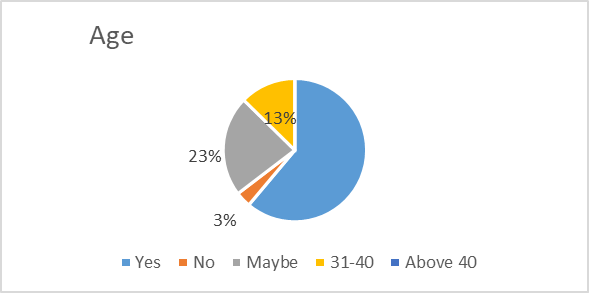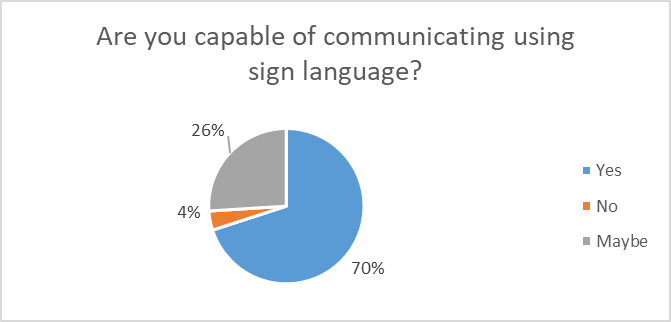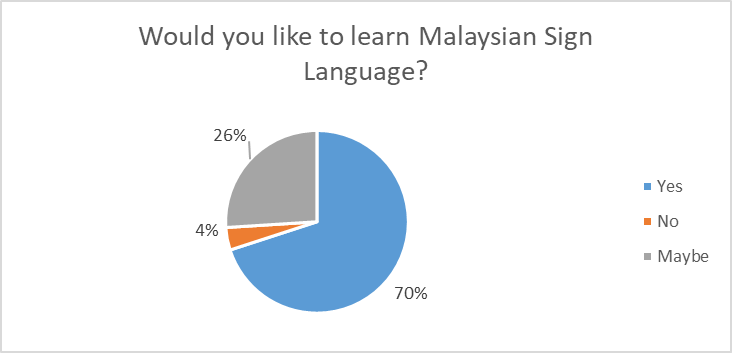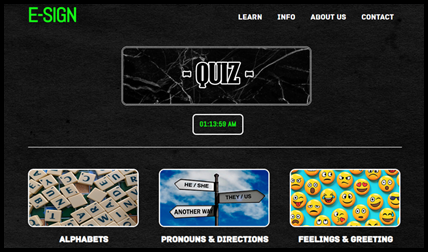Abstract
Communication is vital for everyone to interact in everyday life including for the deaf community. Currently, Malaysian Sign Language (MSL) is the primary language for the deaf community as it is the official sign language in Malaysia. However, the awareness among the Malaysian communities in communicating with deaf individuals is still lacking. Not many people in the communities are able to fully understand or use this sign language. Moreover, the sign language learning methods are not that fascinating to attract the public to learn. Hence, communication gap forms a barrier between the Malaysian public and the deaf community. Therefore, this study was conducted to identify ways to increase the awareness and knowledge of the sign language among the Malaysian communities. In addition, the study also attempted to investigate methods that can contribute in reducing the barrier of communication between the public and the deaf community. The research method applied in this study consisted of two parts, namely survey questionnaire and software development method to develop the website. From the results of the study, the E-Sign Language was developed as an assistive website that can help communities to learn MSL in a more flexible and easy way. The E-Sign Language comprised of two important modules in learning MSL: interactive images and video module and quiz module. In short, the E-Sign Language is expected to contribute in the effort of improving the communication between the Malaysian communities and deaf individuals.
Keywords: Communication, deaf community, e-sign language, Malaysian sign language, website
Introduction
The deaf community is still lagging behind in terms of communication. This is despite the communication is the fundamental part of human interaction. According to Felman (2018), deafness refers to the inability to hear sounds whether completely or partially. Felman stated that “People who are profoundly deaf can hear nothing at all and can find themselves totally reliant on lip-reading or sign language” (2018, p. 1). They are extremely reliant on interpreters who help them to communicate with others due to the fact that not every person knows sign language.
In Malaysia, communities are aware of the deaf community existence but generally naive to understand that deaf community has a unique culture with its own social norms. These deaf individuals usually use Malaysian Sign Language (MSL) to communicate with communities. Yet, the communities are unable to give proper responses or answers since they do not have a clue about sign language. Moreover, the communities appear to have no interest to learn sign language. The inability of the deaf community to communicate well with the Malaysian communities becomes an issue as it creates communication barrier (Mohamed et al., 2020).
Therefore, an alternative system of communication was proposed to solve the issue by utilising the E-Sign Language. The E-Sign Language is an assistive website that allows communities to learn sign language in a more flexible and easy way. The communities are able to learn the basics of sign language, such as how to express feelings, greetings, and many more. The website was built with user-friendly interface which can facilitate to increase the interest for communities to learn sign language. The importance of the study is to ensure that the communities are aware of the difficulty faced by the deaf community in communicating with them. Learning the basic of sign language can help the deaf community which in turn improves the gap in communication.
Sign Language
Using sign language for communication and sharing of information are done visually by making the exact hand shapes and gestures as opposed to auditory. Sign language users consolidated reasonable hand gestures, facial expressions, head and body gestures to impart their sentiments, goals, humour, unpredictable and dynamic thoughts, and the sky is the limit from there (Duke, 2009; Nicoletta et al., 2015). Hasbun (2019) mentioned that sign language basically has its own identity and meaning. Sign language that has been made will slowly transform into something very unique, for example dialects with their vocabularies and own sentence structure rules.
American Sign Language (ASL) is the common local language of the American deaf community (Penilla & Lee, 2016). ASL is a full language with its own sentence structure, accentuation, and punctuation where is made out of exact hand shapes, palm positions, and gestures (Duke, 2009). Whilst the deaf community in Malaysia uses MSL as the official sign language. Before MSL was created, the deaf people in Malaysia principally utilised Penang Sign Language, Selangor Sign Language, or Chinese Sign Language (Hasbun, 2019).
Malaysia Sign Language (MSL)
According the Malaysian Information Network on Disabilities (MIND), the foundation of Malaysian Sign Language (MSL) was established in 1954. There were various signs developed by the youngsters to communicate with each other including Penang Sign Language (Hurlbut, 2003). MIND also claimed that in 1960, a man named Mr. Tan Yap, a pharmacist took courses in understanding sign language in America. With all the knowledge regarding ASL, he began to show how to use sign language to deaf children, medical attendants and some people with no hearing impairment. Meanwhile, Syed Dhiya'uddin Aslah (2012) asserted that there are contrasts in the sentence structure for MSL when contrasted with the Malay Language. The sequence for a sign with a more agreeable speed can ease the process of communicating using sign language. There are signs that are used to act for verbs, pronouns, things, nouns as well as sayings upon utilising finger spelling.
Technology Use by Deaf Community to Communicate
There are few technologies use by deaf community to communicate:
Online Texting or Short Message Services (SMS)
Almost every people nowadays have own smartphone including deaf community. An application such as WhatsApp which requires the internet connection allows deaf community to keep in contact with others and let them have the same experience of chatting like other people.
Textphone
Textphone or also known as Minicom used by deaf community to access telephony. The textphone is telephone with a little screen and a keyboard on where a message can be composed to be gotten by another textphone, or sent through a transfer typist.
Video Chat
According to Angie (2017), video call is a method to interact by seeing each other's appearances through a screen. There are video call applications for both desktop and mobile devices, a webcam can even be attached to a TV screen that has an internet connection. This type of technology aids deaf community in communicating with others by allowing them to use sign language or lips reading.
Problem Statement
In today's community, people with disability are commonly overlooked due to the fact they are different and not like other normal people. There is a perception that learning sign language is hard but the statement can be both true and false (Berke, 2020; Shukor et al., 2015). Generally, it relies upon what kind of sign language that is being attempted to learn. Besides that, learning any language after a certain age is far more challenging which discourages people from learning sign language. Presently, sign language is not being taught in school and only exposed to those in specialised school. Hence, lack of exposure to sign language reduces the reading and learning rates of the hearing impaired, resulting in lower literacy.
Moreover, Malaysian public is essentially deficient with regards to the awareness to speak with people with disability particularly with deaf and hearing impaired. This is due to the majority of Malaysians have only slight knowledge regarding MSL and do not have the intention to learn it. The consciousness of this MSL among the society is very upsetting. This situation creates limited communication that is due to communities’ lack of knowledge regarding sign language. Additionally, this situation causes problems when the deaf individuals are in the public environment. For that reason, the communication gap among the deaf community and the Malaysian public must be addressed (Nurul et al., 2021).
There are various ways to learn MSL and the most common approach used by the communities is to join MSL class. Other than that, MSL could also be learned by using the internet on related sites or to buy books. The approach such as attending class does not allow a person to have the mobility and flexibility to access studying materials. The effort of attending class became futile when the person has zero desire on learning due to traditional learning or a boring class session. Few reasons why traditional learning gets boring after a few minutes are because it lacks of interactive learning materials such as videos images. Learning only with plain text will make the learning process become less interesting and harder to understand (Ahire et al., 2015; Jayatilake et al., 2017).
Research Questions
In the study, three research questions were formed as follows:
How to increase the awareness and the knowledge of sign language among communities?
What can contribute in reducing the barrier of communication between deaf individuals and communities?
How to provide flexible and easy methods in the learning process of sign language to communities?
Purpose of the Study
The purpose of the study is to identify ways to extend the reach of sign language among communities and expose them to sign language knowledge. Further, to investigate methods that can contribute in reducing the barrier of communication between deaf community and the Malaysian public.
Research Methods
The research methods employed in this study involved two parts, whereby part one was the quantitative method utilised for data collection. Questionnaires were distributed to survey participants to identify the communities' responses regarding MSL and their experience with deaf people. The participants of the study were public communities and Universiti Selangor’s (Unisel) students.
The second part of the research method was Extreme Programming Methodology (XP). It was utilised as the software development method to develop the website for this study. The XP process uses the Agile software development methodology.
Questionnaire
The sets of questionnaires that consisted of 13 questions were distributed using online form. The questionnaire contained close-ended questions to empower the respondents to finish the survey with no difficulty. The collected data were used to detect user requirements, important data that may influence the system development, and also the functional and non-functional requirements of the system.
Extreme Programming Methodology
The Extreme Programming Methodology (XP) consists of five phases as the followings:
Planning Phase
This phase was required to identify the objectives, requirements, and desired features for the study. Small deliveries were deliverable as significant to both users and developers as input to proceed to the next phase.
Design Phase
Simple designs were developed to test all the plans. The design was kept as simple as possible as far as it might be feasible. System metaphor was also used to keep development process coordinated. This design was to help in understanding the general plan of the project.
Coding Phase
The coding for the website started by making test units. The programming language used were HTML and PHP and the database for the system was MySQL with XAMMP as a server. Refactoring eliminated repetition and duplications and built the code as a whole while diminishing its dependencies.
Testing Phase
The feedback from users were evaluated by using Unit Testing to test functional requirements. Acceptance testing was also used to indicate the general project was working as determined.
Listening Phase
Listening was vital to perceive the anticipation what the system should do in light of the fact that with tuning in to the client, developers can guarantee they comprehend these requirements. All feedback examined the requirements during the development process and that would turn into an establishment of the new plan.
Findings
The participants for this study consisted of 110 respondents where 83 were public communities and 27 were Unisel’ students as shown in Figure 1. The largest group of the respondents are in the age group of 22 to 30 years old (60%) and the second largest group of the respondents are 13 to 21 years old (35.5%). The smallest percentage of 4.5% was the respondents aged between 31 to 40 years old. The result suggests that the age group of 22 to 30 years old respondents are young adults in the communities.

Table 1 below reveals that 87 respondents (79.1%) have heard of MSL whilst 13 respondents (11.8%) had never heard of MSL. Whereas a small number of respondents (9.1%) indicated that they may have heard it before. This result indicates that the awareness of the deaf community and the importance of MSL have increased among the communities.

Figure 2 shows that 53.6% respondents do not have any capability to communicate using any sign language. Only 9.1% respondents have knowledge and skills to use sign language. As such, the result implies the importance to close the communication gap between the communities and the deaf people are justified.
Table 2 displays the factors preventing communities from learning sign language. The time constraints factor is the main contributor that prevented communities from taking initiative to learn sign language with the highest percentage of 60%. Another preventing factor is the difficulty to learn at 43.6% followed by the financial problem to attend the formal class at 27.3%. Thus, the result indicates that these factors especially the time constraints, existing methods on learning and financial contribute towards the limitations on learning sign language.
Finally, Figure 3 below shows that 70.9% respondents are willing to learn MSL. While 26.4% may be ready and only 2.7% are not ready to learn MSL. This result indicates that the communities are inclined towards learning the sign language.

Results
Based on the findings of the survey, the website to ease the learning process of sign language was developed. The website has a homepage which the main page header consists of the menu and website logo. From the menu bar, the user can select the desired page by clicking the hyperlink in the menu bar. As the user continues to scroll down, the user is able to read more about things related to MSL.

Figure 4 shows the quiz page that consists of three categories, namely alphabets, pronouns and directions and feeling and greetings. Questions are shown once the user clicks on any of available categories. The user is also able to go to another page by clicking the option from the menu bar.
Conclusion
The study showed that the awareness of the Malaysian public towards sign language increased. Therefore, by developing the E-Sign Language website, the communities in Malaysia can have better communication with deaf individuals. This platform is able to be as an alternative method to educate communities on MSL. Towards the end, the gap barrier between the Malaysian communities and the deaf community can be reduced.
Utilizing today's technology and the existence of the internet, the learning process can be made easy and more effective to have a better grasp of things. Besides, combining learning with innovation would be a viable method to advance the learning of MSL for today and future communities in Malaysia. Subsequently, the E-Sign hopes to enable and attract Malaysians to learn, communicate and have a better understanding of deaf individuals.
Acknowledgments
The authors would like to thank the FYP’s student of Universiti Selangor who collaborated to finishing the project.
References
Adamo-Villan, N., & Wilbur, R. B. (2015). ASL-Pro: American Sign Language Animation with Prosodic Elements. Margherita Antona & Constantine Stephanidis (Eds.), In Universal Access in Human-Computer Interaction. Interaction, Springer International Publishing, Cham.
Ahire, P. G., Tilekar, K. B., Jawake, T. A., & Warale, P. B. (2015). Two Way Communicator Between Deaf and Dumb People and Normal People. International Conference on Computing Communication Control and Automation, 641-644.
Angie. (2017). How video chat can transform relationships for people with hearing loss. Hearing Like Me. https://www.hearinglikeme.com/skype-can-transform-relationships-people-hearing-loss/
Berke, J. (2020). Challenges of Learning Sign Language. Very Well Health.
Duke I. (2009). Learn Sign Language in a Hurry: Grasp the Basics of American Sign Language Quickly and Easily. Simon & Schuster.
Felman, A. (2018). What's to know about deafness and hearing loss? Medical News Today.
Hasbun, S. M. (2019). The History of Malaysian Sign Language (and Yes, There Is More Than One Sign Language. https://www.verywellhealth.com/challenges-of-learning-sign-language-1049296
Hurlbut, H. M. (2003). Preliminary Survey of the Signed Languages of Malaysia. Summer Institute of Linguistics.
Jayatilake, L., Darshana, C., Indrajith, G., Madhuwantha, A., & Ellepola, N. (2017). Communication between Deaf-Dumb People and Normal People: Chat Assist. International Journal of Scientific and Research Publications, 7(12). https://www.ijsrp.org/research-paper-1217.php?rp=P727006
Mohamed, J., Salim, N. I. I., Jamil, E. M., Mohd Nazri, A. N., Abdul Hamid, M., Mohamed Ali @ Md Hani, M. H., Md Yasin, M. S., & Jofri, M. H. (2020). Basics Malaysian Sign Language: The Development of Mobile Learning Application. Multidisciplinary Applied Research and Innovation, 2(1), 200-208.
Mohammad, N. A., & Sek, T. K. (2021). Development of aMalaysian Sign Language Interpreter by using Image Recognition Techniques for the Community to Understand the Deaf, Evolution in Electrical and Electronic Engineering, 2(2), 629-636. https://publisher.uthm.edu.my/periodicals/index.php /eeee/article/view/3883
Penilla, A. R., & Lee, A. T. (2016). American Sign Language for Dummies. John Wiley & Sons, Inc.
Shukor, A. Z., Miskon, M. F., Jamaluddin, M. H., Bin Ali Ibrahim, F., Asyraf, M. F., & Bin Bahar, M. B. (2015). A New Data Glove Approach for Malaysian Sign Language Detection. Procedia Computer Science.
Syed Dhiya'uddin Aslah (2012). Malaysian Sign Language Flash Card Mobile Application. Final Year Project Thesis, University Teknologi PETRONAS, Perak.
Copyright information

This work is licensed under a Creative Commons Attribution-NonCommercial-NoDerivatives 4.0 International License.
About this article
Publication Date
31 October 2022
Article Doi
eBook ISBN
978-1-80296-958-0
Publisher
European Publisher
Volume
3
Print ISBN (optional)
-
Edition Number
1st Edition
Pages
1-802
Subjects
Multidisciplinary sciences, sustainable development goals (SDG), urbanisation
Cite this article as:
Sardi, R., Bakri, N. Z., Ahmad, F., & Shafie, S. (2022). E-Sign Language: An Approach For Communities To Learn Malaysian Sign Language. In H. H. Kamaruddin, T. D. N. M. Kamaruddin, T. D. N. S. Yaacob, M. A. M. Kamal, & K. F. Ne'matullah (Eds.), Reimagining Resilient Sustainability: An Integrated Effort in Research, Practices & Education, vol 3. European Proceedings of Multidisciplinary Sciences (pp. 637-645). European Publisher. https://doi.org/10.15405/epms.2022.10.60

